Homemade Ricotta Cavatelli with Sausage and Swiss Chard, and a Giveaway!
Win a Cavatelli Maker
We have a winner!
The winner is SippitySup of the website SippitySup.com!
Congratulazioni, Greg, your Cavatelli Maker is on its way!
I wrote about handmade cavatelli a few months ago, and I was surprised and touched by how many readers commented that it reminded them of childhood memories dished up by moms, aunts and grandmothers. In particular, a number of you mentioned ricotta cavatelli. So here is another childhood favorite, this time with some ricotta in the cavatelli and a sauce made of sweet Italian sausage and Swiss chard.
To make this walk down memory lane complete, Terry Mirri of Artisanal Pasta Tools in Napa, California has given me a Cucina Pro Cavatelli Maker to give away to one lucky reader. Someone can soon make their own cavatelli memories. Terry has enhanced the machine, adding a hand turned olive wood handle. To enter, just write “Thanks Terry” in the comments section below. Click here for contest rules.
I used a delicious Pugliese olive oil that was sent to me by Catherine Faris. Her organic extra virgin Pascarosa oil is made from a blend of Coratina, Toscanina, Leccino and Cerasuola grown in Valle d’Itria in the southeastern tip of Italy. The flavorful, intense oil was a natural choice for this pasta dish. I used the oil to sauté the chard, and it was a long cook, a little over 20 minutes, the kind of cooking that renders vegetables soft and full of meltingly good flavor. The oil’s fruity taste and peppery bite were a perfect match for the spicy chard and peperoncino flakes. A couple of tablespoons swirled into the finished sauce imparted a velvety texture, blending beautifully with the sausage and sweet, fruity Aleppo pepper, bringing the whole dish into a Southern Italian home cooked focus. For more on Pascarosa oil and for purchasing information, visit the company’s site. And for more on Catherine’s life in Puglia visit her blog, Nuovastoria.
Homemade Ricotta Cavatelli with Sausage and Swiss Chard
serves 4 to 6
This satisfying dish makes a great supper, and it’s a classic, no doubt about it. Use sheep’s milk ricotta if you can find it. Otherwise cow’s milk ricotta (made from whole milk, per favore) will be wonderful. The olive oil toasted bread crumbs add a wonderful textural variance. Bart said “I like the crunch.” He was surprised when I told him it was toasted bread crumbs. Don’t skip them. It is easy to make your own bread crumbs. Use day old, even stale bread. I particularly like to use brioche or egg bread. Avoid rye, sourdough or other highly flavored breads. Trim and discard the crust. Cut the bread into 1 inch chunks. Fit the workbowl of a food processor with the steel knife and grind the bread very finely. Store the bread crumbs in a Mason jar or Ziploc bag. You can certainly buy commercially produced dry bread crumbs for this recipe. Purchase the ones with no added spices.
For this recipe you will wind up with more cooked chard than you need. Use the leftovers to stuff ravioli, as a side dish, or in a frittata. Additionally, you will need just half the cavatelli. Make all of the cavatelli and freeze half for later use. To freeze the cavatelli, spread them in 1 layer on a sheet pan and place in the freezer for 1 hour. Transfer the cavatelli to Ziploc or other freezer containers, and freeze for up to two months.
I used a combination of all-purpose flour and semola rimacinata, a hard durum wheat for the cavatelli, a slight adaptation from a recipe included with the machine. The original recipe called for 4 cups of all-purpose flour. The semola though, added a little bite to the cavatelli.
I adapted the sauce recipe from The Mozza Cookbook, by Nancy Silverton. She calls for Aleppo pepper, named for the small Syrian town near the border of Turkey. Also known as Halaby pepper (Halab is Arabic for Aleppo), this fragrant pepper is moderately hot, not scorching, with an almost raisin-like sweetness, and a flavor evocative of cumin and cayenne. It is available at Penzeys, Williams-Sonoma, and other shops. You may substitute a pinch of peperoncino, but I encourage you to use the Aleppo pepper. Its deep aromatic flavor marries beautifully with the sausage and chard.
For the cavatelli
3 cups of all-purpose flour
1 cup of semola rimacinata
1 teaspoon fine sea salt
¼ cup whole milk, plus a bit more, if necessary
16 ounces of whole milk ricotta
1 large egg
Make the dough: sift the flours and salt into a mixing bowl. Make a well in the center.
Drop the ricotta into the well.
In a small measuring cup lightly beat the milk and egg and pour into the well. Use a large fork to slowly blend the ingredients.
When the mixture has come together in a shaggy mass, turn it out onto a spianatoia or work table, and work it into a cohesive mass.
Knead the dough for about 3 minutes. Gather the dough into a ball, and cut it in half. Wrap each half in plastic, and set the dough aside to rest for about 10 minutes.
Form the cavatelli: cover two large sheet pans with clean lint-free towels and lightly dust the towels with flour. Set the trays aside. Unwrap one piece of dough, leaving the other wrapped. Flour the spianatoia and roll the dough into an oval or rectangle, about ½ inch thick. Use a knife or pizza cutter to cut the dough lengthwise into ½ inch strips. Working with one strip at a time, flour the strip well, and place it on the counter right to left. With the palms of your hands, roll it into a rope, slightly less than ½ inch in diameter.
Flour the rope well, and pass it through the cavatelli maker, separating the cavatelli as they fall to the board. For smaller cavatelli, make the ropes narrower in diameter. If the cavatelli stick to the machine, roll the rope in more flour.
Place the formed cavatelli on the prepared trays, and allow them to dry slightly while you make the sauce.
Cook the cavatelli: bring 6 quarts of water to a rolling boil. Add 3 tablespoons of coarse sea salt and stir well. Add the cavatelli and boil about 8 to 10 minutes, depending on their size. The timing for cooking the cavatelli works well if you start cooking them just before the sauce is done. See the sauce recipe below for more detail.
For the sauce
1 pound of sweet Italian sausage, casings removed
1 bunch of red Swiss chard, rinsed and drained
5 cloves of garlic, peeled and cut into paper-thin slices
½ cup minced yellow onion
1 cup of chicken stock
Pinch of peperoncino flakes (crushed red pepper flakes)
½ teaspoon of ground Aleppo pepper
2 tablespoons of unsalted butter
Fine sea salt
Pascarosa Organic Extra Virgin Olive Oil
Parmigiano-Reggiano
½ cup of dry bread crumbs
Make the toasted bread crumbs: combine ½ cup dry bread crumbs and ¼ teaspoon fine sea salt in a medium sauté pan. Over medium heat drizzle 1 tablespoon of Pascarosa organic extra virgin olive oil over the crumbs, tossing with a rubber spatula to coat thoroughly. At first the oil and bread will clump, but with a bit of stirring, the oil will mix uniformly. Keep tossing and stirring until the crumbs are crispy and have taken on a golden tone, about 5 minutes. Transfer the toasted bread crumbs to a small bowl and set aside.
Make the sauce and cook the cavatelli: set the pasta water on to boil. Trim the center stalks from the chard and discard the stalks or reserve for another use. Cut the chard crosswise into ½ inch strips. Pour ¼ cup of extra virgin olive oil into a 12-inch sauté pan. Add the sliced garlic and onion and heat over medium to medium-low heat. Cook about 5 minutes, stirring several times, until softened and the onion appears translucent. Do not allow the onion and garlic to color. Add the chard, tossing to coat. It may seem like too much chard for the pan, but it will wilt down relatively quickly. Add ½ teaspoon of fine sea salt and a generous pinch of peperoncino flakes. Once the chard is well coated, lower the heat slightly, cover the pan and cook until the chard is soft and darkened and the vegetables have come together in a mass, about 20 minutes, stirring occasionally. Turn off the heat and set the pan aside to cool slightly. When cool, transfer the chard to a cutting board and chop it extremely finely, almost to a puree. Set aside a generous ¼ cup of chard for use in the sauce. Transfer the remaining chard to a small glass container, and store, well covered, in the refrigerator.
Wipe the sauté pan clean and add 1 tablespoon of extra virgin olive oil. Warm the sauté pan over high heat for about 1 minute. Add the sausage and sear it well, about 2 minutes, without stirring. Reduce the heat slightly and continue cooking, breaking up the sausage, until cooked thoroughly, about 5 to 6 minutes.
Salt the boiling water and add the cavatelli to it now.
Add ¼ cup of chopped chard to the sausage, and cook about 2 minutes to heat through, stirring well. Add the Aleppo pepper and the chicken stock and stir well. Cook about 2 to 3 minutes. Add 2 tablespoons of butter and stir well to combine. Turn off the heat under the sauté pan while the cavatelli cook.
Finish the dish: just before the cavatelli are fully cooked, about 1 minute shy, drain and add them to the pan with the sauce. Turn the heat to high and cook until the cavatelli are ready, stirring with a wooden or rubber spatula, adding a tablespoon or two of pasta water if necessary to loosen the sauce. Finishing the cavatelli in the sauce like this allows the pasta to absorb the flavors of the sauce, enriching the pasta, producing a much tastier dish than if the cooked pasta is added to the finished sauce.
Remove the pan from the heat and add 2 tablespoons of extra virgin olive oil and ¼ cup of grated Parmigiano-Reggiano. Stir well. Arrange the pasta on the serving plates and top with a sprinkling of toasted bread crumbs. Pass more Parmigiano at the table.
A note on the care and feeding of cavatelli machines: like your pasta machine, never immerse a cavatelli maker in water. Use a towel to wipe it clean, a brush for the nooks and crannies, maybe a little canned air. DO NOT IMMERSE THE MACHINE IN WATER. NOT EVER.
Pascarosa Organic Extra Virgin Olive Oil is available from Pascarosa
Semola rimacinata flour is available from Olio2go
The contest is open to anyone with a shipping address in the U.S. and its territories. Read the contest rules here, and write “Thanks Terry” in your comment.
Photo of Red Swiss Chard by mercedesfromtheeighties
Disclosure: I received the Pascarosa organic extra virgin olive oil for free. I only recommend products or services I use personally and believe will be good for my readers. I otherwise have no affiliation with any product, manufacturer, or site mentioned in this article.
Note: You can click on any picture for a larger image, and to see a slide show!
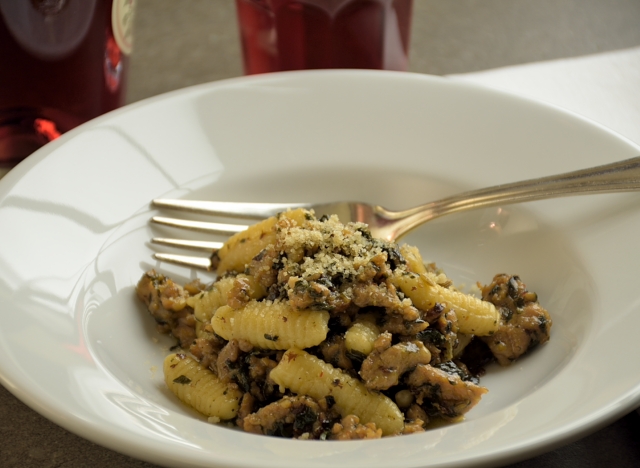

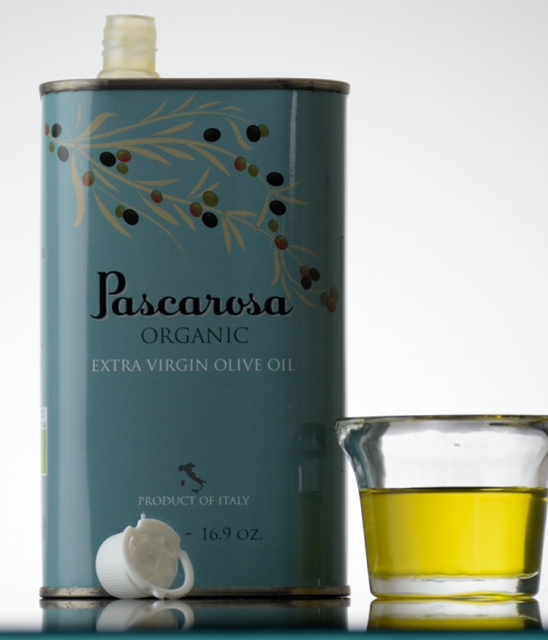
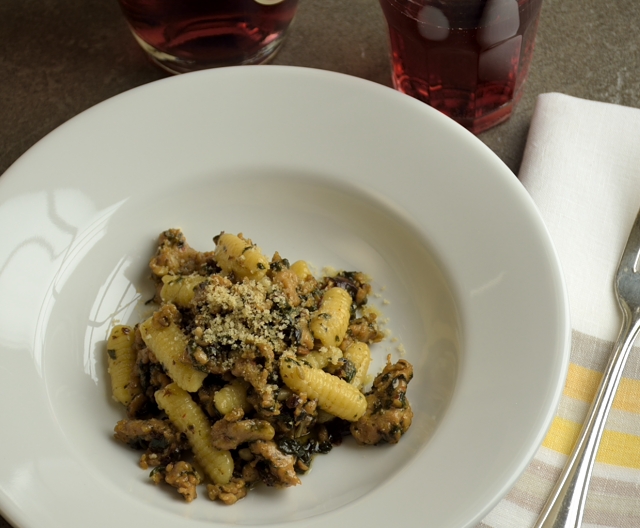

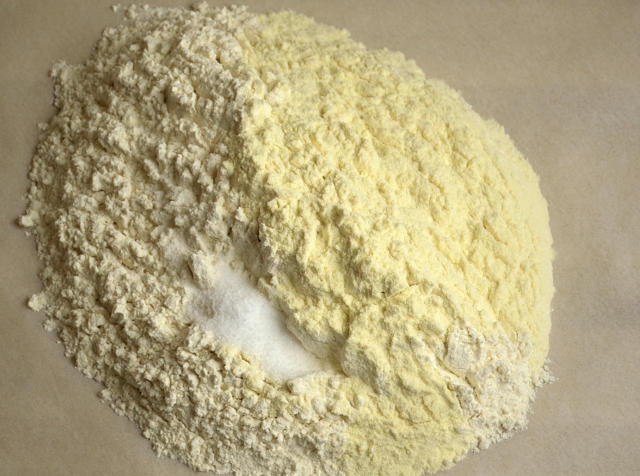
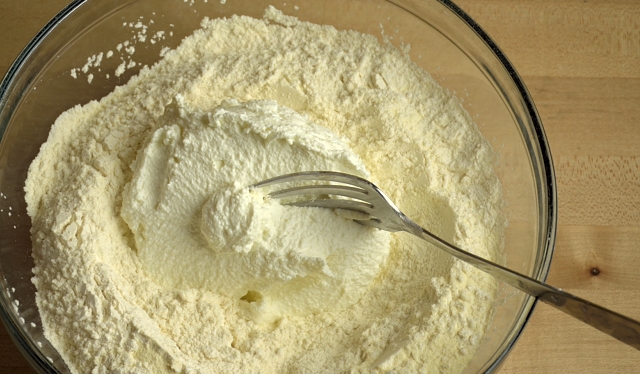

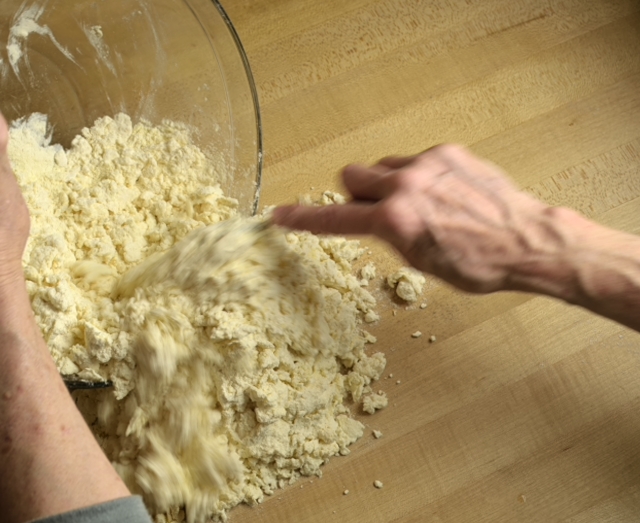
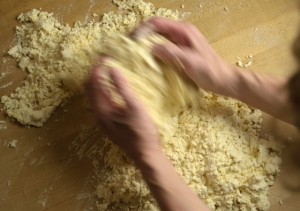



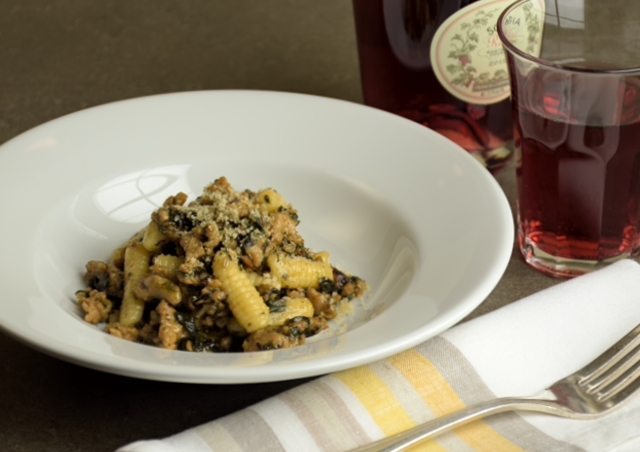
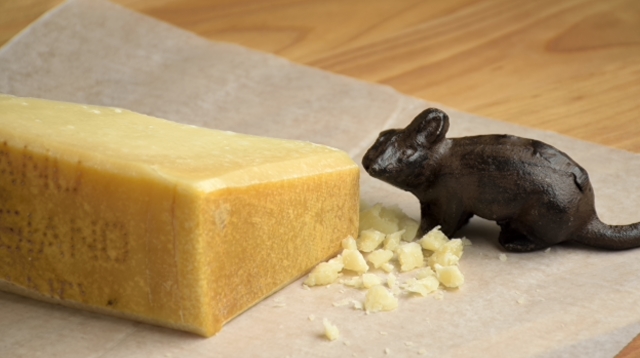

Tuesday, April 8th 2014 at 9:27 am |
Thanks Terri, a great post looks DELICIOSO!!!! ESTOY APRENDIENDO A PREPARAR PASTA, GRACIAS POR COMPARTIR TUS CONOCIMIENTOS
Tuesday, April 8th 2014 at 10:51 am |
Well, I should have read this post after lunch — I’m not going to be able to concentrate now:) Beautiful post and so informative. I look forward to reading your site regularly.
Wednesday, April 9th 2014 at 12:55 am |
Adri, I am always so impressed by the amount of time and effort that goes into every single one of your blog posts. The incredible detail, the beautiful photos, the history, the clear explanations. You really are the best. I don’t think I ever asked you if you have published a cookbook based on your blog. If you have not, you really should.
Wednesday, April 9th 2014 at 6:07 am |
Hi Trisha,
Thank you so much. I love doing this, and I feel a distinct sense of accomplishment. To answer your question, I have not published a cookbook. Perhaps one day – after lots of research travel in Italy!
Wednesday, April 9th 2014 at 9:49 am |
What a lovely giveaway . Thanks Terry
Wednesday, April 9th 2014 at 12:17 pm |
Thanks, Terry! Will absolutely try this recipe…Will do it the old fashioned way by hand, for now.
Wednesday, April 9th 2014 at 12:19 pm |
Thanks Terry!! Cavatelli sono buoni!
Wednesday, April 9th 2014 at 12:50 pm |
Yum! Thanks Terry!
Wednesday, April 9th 2014 at 12:52 pm |
Thanks Terry
Wednesday, April 9th 2014 at 1:01 pm |
bebeitantanti bei ricordi della nonna……thanks Terry
Wednesday, April 9th 2014 at 1:09 pm |
Looks wonderful! The pasta came out gorgeous.
Wednesday, April 9th 2014 at 1:32 pm |
Thanks, Terry! Cavatelli are like little poems.
Wednesday, April 9th 2014 at 2:12 pm |
Quell’attrezzo per fare i cavatelli è geniale, la pasta è venuta benissimo !Un piatto saporito e molto sfizioso !Un abbraccio
Wednesday, April 9th 2014 at 2:16 pm |
Grazie, Chiara!
Wednesday, April 9th 2014 at 2:46 pm |
Thanks Terry! Those cavatelli look delicious! Have you tried other combinations of flour, such as whole wheat or 00?
Wednesday, April 9th 2014 at 2:46 pm |
Thanks Terry. My nonna, aunts and mother would spend hours making cavatelli by hand as they pressed small pieces of dough with their thumbs and pulled across a small, finely-grooved wooden paddle.
Wednesday, April 9th 2014 at 3:40 pm |
Thanks Terry! I love cavatelli
Wednesday, April 9th 2014 at 6:19 pm |
Grazie, Terry! This would be a wonderful addition to my kitchen! Love the photos and recipes, Adri….particularly your chard. Mine is almost gone..I didn’t plant enough!!!
Wednesday, April 9th 2014 at 6:33 pm |
Thanks, Terri! Cavatelli is my favorite \”nonna\” memory!
Wednesday, April 9th 2014 at 7:58 pm |
Thanks Terry and also Adri for the giveaway and the wonderful recipe. I always make cavatelli by hand with just flour and water as we do in Calabria and I have never tried them with the addition of ricotta. I am going to try it with the ricotta this week-end as I have some homemade ricotta but I will have to make them again by hand. I would love to win the cavatelli maker so I can take a break from shaping cavatelli by hand.
Wednesday, April 9th 2014 at 8:12 pm |
Thanks, Terry!
Wednesday, April 9th 2014 at 11:43 pm |
Thanks Terry
Friday, April 11th 2014 at 6:19 am |
Your cavatelli look amazing! I’ll be making this for sure. I love the combination of chard and sausage. Thanks Adri.
Friday, April 11th 2014 at 6:56 am |
Ciao Janie,
Thanks, I love this combo! Alla prossima!